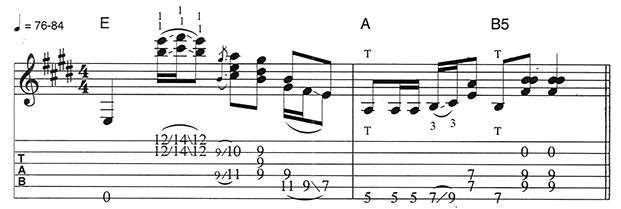This Simple Three-Chord Progression Opens the Door to Many Genres
A knowledge of the tried-and-true fretboard applications of this triumvirate will make you a more versatile player and composer.

The I, IV, and V chords are the three most common and arguably the most important harmonic elements in the musical universe. Built off of the first, fourth, and fifth notes of any major or minor scale, these three chords form the basis for much of the music found in several genres.
While you may already have a basic understanding of this concept, a deep knowledge of the tried-and-true fretboard applications of this triumvirate will make you a more versatile player and composer.
Rockabilly
Figure 1 is a raved-up, ‘round-the-clock rockabilly I-IV-V sequence in the key of A. It gives all three basic triads a makeover, adding slick-sounding 6th, 9th, and 13th intervallic extensions. Voiced on the top four strings, it evokes the tight-knot arrangements of a big-band horn section.

Sixties Rock
Figure 2 is a Beatles-esque barnburner. Dig the Fab-sounding switch from major to minor on the IV chord, and treat the slash chords Dm/F and E7/G# as extensions of the regular IV and V harmonies.

No stranger to the creative application of basic theory, Jimi Hendrix was known for his artistry at playing rhythm and lead guitar simultaneously. Figure 3 evokes the way he would masterfully spin a simple I-IV-V in E into a bold sonic experience. For added mojo, reach your fretting-hand thumb around the neck to grab the bass notes on the A (IV) and B5 (B) chords.

Incidentally, have you ever considered playing a diatonic I-IV-V progression completely with harmonics? It’s possible in the key of D – you can spell out all the notes of the D, G, and A triads (which, incidentally, contain all seven notes of the D major scale), as demonstrated in Figure 4.

Classical
For Figure 5, let’s look to the classics and template the solo guitar compositions of Carcassi and Sor. Look beneath the rolling triplets, ascending first-string melody, and 5th- and 7th-fret big-stretch barres – there you will find a simple Em-Am-B7b9 progression, also known as a I-IV-V in the key of E minor.
In fact, many complex-sounding classical arrangements can be reduced to simple I-IV-V structures. Roll over Beethoven, indeed!

Play through the seemingly atonal series of chromatically ascending tritone intervals in Figure 6A (first measure).
Now reorder them slightly, adding open A-, D-, and E-string bass notes, as demonstrated in Figure 6B (second and third measures), and see how they become the 3rds and 7ths of the chords in a funky I7-IV7-V7 progression in the key of A, or A7-D7-E7.

These examples should give you plenty of tools to create your own I-IV-V magic, so pick a key and a type of music (or several), and have at it!
Get The Pick Newsletter
All the latest guitar news, interviews, lessons, reviews, deals and more, direct to your inbox!
“Write for five minutes a day. I mean, who can’t manage that?” Mike Stern's top five guitar tips include one simple fix to help you develop your personal guitar style
"It’s like you’re making a statement. And you never know where it’ll lead." Pete Thorn shares the tip that convinced Joe Satriani he was the right guitarist for the SatchVai Band










